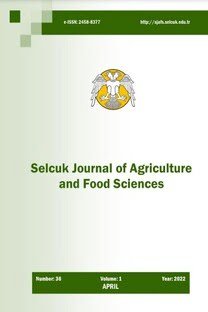Agroekosistemlerde Heteroptera biyoçeşitliliği ve biyolojik indikatör olarak rolü
Heteroptera (Hemiptera) genellikle "true bugs" olarak is imlendirilmekte ve oldukça farklılık gösteren bir takım olarak bilinmektedir. Sularda ve karasal ortamlarda yaşamlarını sürdürürler. Doğada etkili predator familyalar içermesine rağmen Heteroptera, daha çok bitki zararlısı olarak tanınmaktadır. Heteroptera faunası oldukça zengin olup, geniş bir familya ve tür çeşitliliğiyle, ekosistemde çok önemli bir yere sahiptirler. Faydalı ve zararlı türleri bir arada bulundurup, biyolojikçeşitlilik çalışmalarda kullanılabilecek potansiyele sahiptirler.
Anahtar Kelimeler:
agroekolojik bölgeler, biyoçeşitlilik, ekosistem, Hemiptera, Heteroptera, ekoloji, indikatörler
Biodiversity of Heteroptera in agroecosystems and role of it in bioindication
Heteroptera (Hemiptera) are commonly called "true bugs". They appear as a rather diverse is known. Present numerous adaptations to aquatic and terrestrial habitats. Although Heteroptera include effective predators, they have long been known as plant-damaging. Heteropteran fauna is rather abundant. It owns wide and rich family and species diversity. It has an important role in ecosystems. The include both pest and benefit species and they have a potential to be used in biodiversity researches.
Keywords:
agroecological zones, biodiversity, ecosystems, Hemiptera, Heteroptera, ecology, indicators,
___
- Debroy, A.K. and B.C. Pathak, 1971. Possible uses of lac dye. Indian J. Appl. Chem., 34 (6): 243-8, 277-282.
- Demirsoy, A., 1990. Yaşamın Temel Kuralları, Omurgasızlar/Böcekler, Cilt II, Kısım II, Meteksan matbaacılık, s. 461-470.
- Dolling, W.R., 1991. The Hemiptera. Oxford University Press, Oxford, 274 pp. Ehanno, B., 1987b. Les Heteropteres Mirides de France II A. Inventaire et synthese ecologiques; Coll. Inventaires de faune et de flöre, Fasc. 40. Mus. Nat. Hist. Nat., Seer, faune et flöre, Paris, pp. 97-647.
- Ehanno, B., 1987c. Les Heteropteres Mirides de France. II B: Inventaire biogeographique et atlas. Coll. Inventaires de faune et de flöre, Fasc. 42. Mus. Nat. Hist. Nat., Seer, faune et flore, Paris, pp. 648-1075.
- Essig, E.O., 1942. College Entomology. MacMillan, Newyork, 900 pp. Fauvel, G., 1974. Sur l'alimentation pollinique d'un anthocoride pre"dateur Orius vicinus (Rib). (He-miptere). Ann. Zool. Ecol. Anim. 6, 245-258.
- Fauvel, G., 1999. Diversity of Heteroptera in agroeco-systems: role of sustainability and bioindication. Agriculture, Ecosystems and Environment, vol.: 74, p. 275-303.
- Favretto, M.R., Paoletti, M.G., Lorenzoni, G.G., Dioli, P., 1988. Lo scambio di invertebrati tra un relitto di bosco planiziale ed agroecosistemi contigui. L'artropodofauna del bosco di Lison. Thalassia Salentina 18, 481-510.
- Heiss, E., J.3 Pericart, 1983. Revision of Palaearctic Piesmatidae (Heteroptera). Mitt. Münch. Ent. Ges. 73, 61-171.
- Kot, J., T., Bilewicz-Pawinska, 1989. Preliminary investigation on the Maize entomofauna in the Warsaw region. Acta Phytopathol. Entomol. Hung. 24, 141-144.
- Kula, E. and J. Bryja, 2002. Comparison of various sampling methods for evaluation of Biodiversity of true bugs (Heteroptera) in a birch forest. Eko-logia, vol.:21,s. 137-147.
- Lodos, N., 1986. Türkiye Entomolojisi (Genel, Uygulamalı ve Faunistik), Cilt II. Ege Üniversitesi Ziraat Fakültesi Yayınları No.;429, 539 s.
- Moulet, P., 1995. Heemipteres Coreoidea (Coreidae, Rhopalidae, Alydidae) Pyrrhocoridae, Stenoce-phalidae euro-mediterraneens.
- Önder, F., Y. Karsavuran, ve S. Tezcan, 1992. Çevre kirliliği Araştırmalarında Biyoindikatör böceklerin rolü ve önemi. Ege Üniversitesi Ziraat Fakül¬tesi Dergisi Cilt: 29, Sayı: 1, s. 111-125.
- Papacek, M., 2001. Small aquatic and ripicolous bugs (Heteroptera: Nepomorpha) as predators and prey: The question of economic importance. European Journal of Entomology, vol. 98, no. 1, pp. 1-12; ISSN: 1210-5759.
- Pedigo, L., G.D. Bunting, (Ed.) 1994. Handbook of Sampling Methods in Agriculture. CRC Press, Boca Raton, 714 pp.
- Saulich, A.-K.H., D.L., Musolin, 1996. Univoltinism and its regulation in some temperate true bugs (Heteroptera). Eur. J. Entomol. 93, 507-518.
- Schulz-Baldes, M. 1989. The sea-skater Halobates micans: An open ocean bioindicator for cadmium distribution in Atlantic surface waters. Marine Biology, vol. 102, no. 2, pp. 211-215; ISSN: 0025-3162.
- Tavella, L., Arzone, A., Alma, A., Galliano, A., 1996. IPM application in peach orchards against Lygus rugulipennis Poppius. IOBC/WPRS Bull. 19 (4), 160-164.
- ISSN: 1300-5774
- Yayın Aralığı: Yılda 3 Sayı
- Başlangıç: 2018
- Yayıncı: Selçuk Üniv. Ziraat Fak.
Sayıdaki Diğer Makaleler
Konya kenti peyzaj gelişim stratejileri
Konya ili merkez ilçeri besi sığırı barınaklarının iklimsel analizi
Heavy metal accumulation in irrigated soil with wastewater
MUSTAFA KARATAŞ, Şükrü DURSUN, Celalettin ÖZDEMİR, Mehmet Emin ARGUN
Derin kuyu pompaj tesislerinde titreşim hızı ve gürültü düzeyinin belirlenmesi
Sedat ÇALIŞIR, Cevat AYDIN, Hakan O. MENGEŞ
MEHMET HAMURCU, Mustafa HARMANKAYA, Süleyman SOYLU, Fatma GÖKMEN, Sait GEZGİN
Domateste görülen külleme hastalık etmenleri
Samsun - Bafra Ovası topraklarının CBS yardımıyla verimlilik indekslerinin (PI) belirlenmesi
